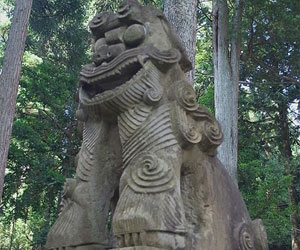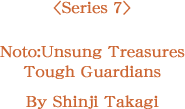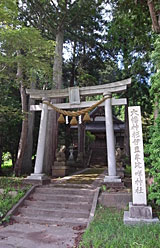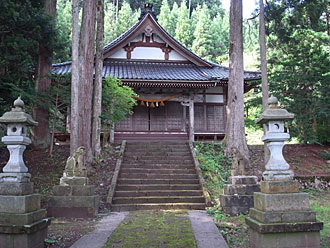

|
 |
At handmadejapan.com we have been introducing various skilled handmade crafts since 2000. We have sort to expose the essence of those crafts which are characterized and deeply rooted in the areas where the craftspeople live, are affect by local climate and history. And at the same time there has been a chance to enjoy the individual qualities of ceramics both rustic and fine, cloth, paper and items made of bamboo, too. In a series of ten articles under the heading of Noto: Unsung Treasures, the architect Shinji Takagi, who was born and raised in Wajima in Ishikawa prefecture, seeks to identify some of the interesting buildings and their background, old local customs and various pieces of engaging landscape, all of which might not make it into a tourist guide but are nevertheless of considerable interest. Having left the Noto Satoyama Coast Road, which runs between Kanazawa and Wajima, we come to Doai in the district of Mii, where there is a three-road junction on the outskirts of Wajima itself. Taking the righthand fork here, paddy fields stretch out toward the south and we soon come to the hamlet of Hongo. A little further on surrounded by greenery is the Obata Kamusugi Izumu Hime Shrine, which used to have a reed-thatched roof. There have been some changes in Mii, however. It was famous for its stands of cultivated Hiba arborvitae trees, a tree designated as being of special value by Ishikawa prefecture. Back in about 1993 there were some 30 or so reed-thatched houses here, too. Since then, however, along with the general changes in social conditions in Japan, the local neighborhood system of interdependence, which was formally relied on to re-thatch such buildings, has more or less broken down and galvanized iron roofing has replaced the traditional thatch. In some cases a second floor has been added to some of these dwellings and tiles have become the preferred roofing material. Now that former rural setting has changed. Some years ago the large reed-thatched roofs of the houses of the gaffers, who had acquired their wealth and social standing from forestry in the area, stood proudly against a backdrop of strictly planted stands of hiba, creating a pastoral scene of such quality, which alas, has now been assigned to memory. |
 |
 |
|
After passing through the shrine torii, there are two typical lion-dog statues standing either side of the path. But closer to the shrine itself there are two more lion-dogs. These are something out of the ordinary. They have the strangest appearance, which is likely to prompt an exclamation of surprise. Whatever do they look like?! They have a rather gruff expression and look similar to the Shiisaa lions found beside entrances or on roofs of house in Okinawa. Then again they are rather sphinxlike. It is difficult to decide what they resemble and as we are turning various ideas over in our head, we come to the conclusion that being of such an unusual appearance they must have perhaps been made by some visitor from outer space! I first came across these particular statues more than 30 years ago. Since then I have been interested in shrine lion-dogs and I have made a point of visiting shrines to study them whenever I am traveling around Japan. These two at the Obata Shrine are, however, the strangest I have come across. In the Mii district there is a legend about an evil monkey or Saru-Oni. With the idea of warding off this mischievous ape, a vice-shogun, Kamu Sugi Hime is enshrined here. There is clearly a strong connection between the legend and the Obata Shrine as there is a votive image of the legend hanging in the main building. So, who knows, perhaps these strange lion-dogs are connected somehow with the legend of the evil monkey. Even the people of Mii seem to have no idea of where these lion-dogs came from and there are no records of when they were made or of who they may have been made by. Some people seem to think they may have their origins in South Asia and their overall appearance and the expression on their faces makes them look slightly humorous and yet appealing. Many of the local people question just what lead to their making but it is all very much puzzling. Just who could have made such eccentric looking statues to go on display in an essentially conservative rural community? Could they have been made by a stone mason who came from afar to the Noto peninsula? Perhaps the mason was so well treated by the local people that they carved these two lion-dogs in appreciation of the kindness they were shown. Who is to say? Located in the Mii district of Hongo, the Obata Shrine is where even today the Obata Goja Festival is held on 3rd. May every year. One of the events during this festival is a lion dance. Although the shrine itself has been splendidly restored and now has a tiled roof replacing the original reed thatch, sadly there are now so few children in the area, it is difficult to know whether or not the tradition of the lion dance can be continued with any certainty. So, with all its traditions and history through the ages, it would be interesting to see the changes which have taken place in the vicinity as well as in Japan at large through the eyes of these two almost certainly unique lion-dogs. |
Shinji Takagi---Architect Born in Wajima in 1942. Worked on many projects using local materials and true lacquer for shops, houses and a variety of interior design schemes. Principal work includes Yuyado Sakamoto in Suzu: the repair and renovation of the true lacquer craftsman's house, Nurishi no Ie in Wajima: Meiso no Yakata in Toga, Toyama prefecture: the store Kombuya Shirai in Nanao and Kanazawa: a store selling Japanese candles, Takazawa Shoten in Nanao. Member on the Wajima City Council for the Protection of Cultural Properties Committee. Director of the NPO, Ishikawa Reed Thatch Culture Study Group. Bill Tingey---Translator Chief Designer to David Hicks in London before moving to Japan in 1976 and gaining a Masters Degree in History of Architecture. Worked in Japan as a photographer, designer, writer and translator. Returned to UK to continue work in 2000. |
| (2015/5 Yuko Yokoyama) |
|
(C)Copyright 2004 Jomon-sha Inc, All rights reserved. |